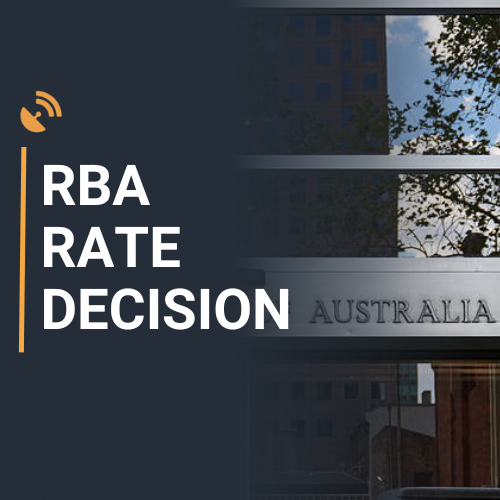Bullock Speech: RBA Governor discusses interest rate path after extending pause

Reserve Bank of Australia (RBA) Governor Michele Bullock is speaking at the press conference, explaining the reason behind holding the interest rate at a 12-year high of 4.35% for the ninth consecutive meeting in December.
The central bank, however, softened its hawkish tone, hinting at a dovish pivot early next year.
Bullock is taking questions from the press as part of a new reporting format for the central bank that started this year.
Key quotes from the RBA press conference
Discussed upside inflation risks had eased but not gone away.
Change in wording of statement is deliberate.
Board has noted that data has been softer.
Will be watching all data including employment.
Did not discuss interest rate cut.
Did not discuss raising rates either.
Cannot say when will be confident on inflation.
Economic Indicator
RBA Press Conference
Following the Reserve Bank of Australia’s (RBA) economic policy decision, the Governor delivers a press conference explaining the monetary policy decision. The usual format is a roughly one-hour presser starting with prepared remarks and then opening to questions from the press. Hawkish comments tend to boost the Australian Dollar (AUD), while on the opposite, a dovish message tends to weaken it.
Read more.Next release: Tue Dec 10, 2024 04:30
Frequency: Irregular
Consensus: -
Previous: -
Source: Reserve Bank of Australia
This section below was published at 03:30 GMT to cover the Reserve Bank of Australia's monetary policy announcements and the initial market reaction.
The Reserve Bank of Australia (RBA) left the Official Cash Rate (OCR) unchanged at 4.35% following the conclusion of its December policy meeting.
The decision was broadly in line with the market expectations.
The RBA made no changes to its policy settings for the ninth consecutive meeting. The central bank hiked the benchmark rate by 25 basis points (bps) in November 2023.
Summary of the RBA monetary policy statement
Underlying inflation remains too high.
The outlook remains uncertain.
Board is gaining some confidence that inflationary pressures are declining in line with these recent forecasts, but risks remain.
Board will continue to rely upon the data and the evolving assessment of risks to guide its decisions.
While underlying inflation is still high, other recent data on economic activity have been mixed, but on balance softer than expected in November.
There remains a high level of uncertainty about the outlook abroad.
Wage pressures have eased more than expected in the November SMP.
Taking account of recent data, the board’s assessment is that monetary policy remains restrictive and is working as anticipated.
AUD/USD reaction to the RBA interest rate decision
The Australian Dollar extends the downside on the RBA’s extended pause. The AUD/USD pair is losing 0.87% on the day to trade at 0.6381 as of writing.
Australian Dollar PRICE Today
The table below shows the percentage change of Australian Dollar (AUD) against listed major currencies today. Australian Dollar was the weakest against the Swiss Franc.
| USD | EUR | GBP | JPY | CAD | AUD | NZD | CHF | |
|---|---|---|---|---|---|---|---|---|
| USD | 0.00% | 0.07% | 0.02% | 0.12% | 0.81% | 0.67% | -0.05% | |
| EUR | 0.00% | 0.08% | 0.00% | 0.11% | 0.81% | 0.68% | -0.04% | |
| GBP | -0.07% | -0.08% | -0.10% | 0.03% | 0.74% | 0.59% | -0.13% | |
| JPY | -0.02% | 0.00% | 0.10% | 0.11% | 0.81% | 0.65% | -0.05% | |
| CAD | -0.12% | -0.11% | -0.03% | -0.11% | 0.70% | 0.50% | -0.15% | |
| AUD | -0.81% | -0.81% | -0.74% | -0.81% | -0.70% | -0.15% | -0.85% | |
| NZD | -0.67% | -0.68% | -0.59% | -0.65% | -0.50% | 0.15% | -0.71% | |
| CHF | 0.05% | 0.04% | 0.13% | 0.05% | 0.15% | 0.85% | 0.71% |
The heat map shows percentage changes of major currencies against each other. The base currency is picked from the left column, while the quote currency is picked from the top row. For example, if you pick the Australian Dollar from the left column and move along the horizontal line to the US Dollar, the percentage change displayed in the box will represent AUD (base)/USD (quote).
This section below was published on December 9 at 21:45 GMT as a preview of the Reserve Bank of Australia (RBA) policy announcements.
- The Reserve Bank of Australia is expected to hold the interest rate at 4.35% in December.
- Australian central bank Governor Michele Bullock’s comments will be closely scrutinized to gauge when could the RBA trim its benchmark rate.
- The volatility around the Australian Dollar is set to ramp up on the RBA policy announcements.
The Reserve Bank of Australia (RBA) is unlikely to alter its stance on the monetary policy for the ninth meeting in a row on Tuesday.
The RBA is expected to hold the Official Cash Rate (OCR) steady at 4.35% following its final policy meeting this year. The decision will be announced at 03:30 GMT and Governor Michele Bullock’s press conference will follow at 04:30 GMT.
Focus on RBA Governor Bullock’s outlook on interest rate
The RBA remains an outlier among many other central banks from developed markets that already embarked on the easing trajectory. Elevated core and services inflation and relatively tight labor market conditions in Australia are the primary reasons behind the bank’s cautious stance.
The Australian Unemployment Rate remained at 4.1% in October for the third consecutive month. The economy added 9,700 full-time jobs and 6,200 part-time roles, making a net change of 15,900 positions. The RBA’s closely-watched inflation gauge, the annual Trimmed Mean Consumer Price Index (CPI), slowed to 3.5% from 4.0% in the third quarter but stayed well above the Bank’s 2%-3% target.
RBA Governor Michele Bullock said late last month that “given the tightness in Australia’s labor market, along with our assessment that the level of demand still exceeds supply in the broader economy, we expect it will take a little longer for inflation to settle at target.”
She further noted that Australia’s core inflation is “too high” to consider interest rate cuts in the near term.
However, Australia's economy in the third quarter grew at the slowest annual pace since the pandemic. The OZ nation’s Gross Domestic Product (GDP) rose 0.3% in the September quarter, missing market forecasts of 0.4%. The surprisingly weak growth numbers undermined the RBA’s forecast for a 1.5% growth by the end of the year.
Weaker-than-expected GDP growth made markets almost fully price in a rate cut next April at 96% (from 73% before) and saw 35 basis points (bps) easing for May (from 28 bps before), according to Refinitive interest rate probabilities data.
Therefore, the policy statement and Governor Bullock’s comments will be key to determining the RBA’s outlook on rates heading into the new year.
Previewing the RBA policy decision, TD Securities (TDS) analysts said: “Q3 GDP underwhelmed, but it's unlikely to influence the RBA's monetary policy outlook. Unless there are sharp job losses and the unemployment rate rises to 4.5% in short order, the absolute earliest the Bank could cut is in May. We are calling August.”
How will the Reserve Bank of Australia decision impact AUD/USD?
RBA Governor Michele Bullock is widely expected to repeat that “the Board is not ruling anything in or out” and “think there are still risks on the upside for inflation.” The Bank’s wait-and-see approach will likely provide the much-needed respite to the Australian Dollar (AUD), lifting the AUD/USD pair from four-month troughs below 0.6400.
If Bullock expresses concerns about the slowing economy while noting that the Board discussed rate cuts as an option at the meeting, the Aussie is expected to face intense selling pressure, revisiting levels last unseen since October 2023.
Dhwani Mehta, Asian Session Lead Analyst at FXStreet, notes key technicals for trading AUD/USD on the policy announcements.
“After charting a 50-day Simple Moving Average (SMA) and 200-day SMA Death Cross on December 4, AUD/USD remains exposed to downside risks in the run-up to the RBA showdown. The 14-day Relative Strength Index (RSI) remains way below the 50 level, currently near 40, adding credence to bearish potential.”
“A dovish surprise from the Bank could fuel a fresh AUD/USD decline toward the August 5 low of 0.6348, below which the 0.6300 level will come into play. The next downside target aligns at the October 2023 low of 0.6270. Alternatively, buyers need acceptance above the 21-day SMA at 0.6484 to initiate a meaningful recovery. Further up, the November 25 high of 0.6550 will be tested before encountering major daily SMAs near the 0.6620 region,” Dhwani adds.
Australian Dollar FAQs
One of the most significant factors for the Australian Dollar (AUD) is the level of interest rates set by the Reserve Bank of Australia (RBA). Because Australia is a resource-rich country another key driver is the price of its biggest export, Iron Ore. The health of the Chinese economy, its largest trading partner, is a factor, as well as inflation in Australia, its growth rate and Trade Balance. Market sentiment – whether investors are taking on more risky assets (risk-on) or seeking safe-havens (risk-off) – is also a factor, with risk-on positive for AUD.
The Reserve Bank of Australia (RBA) influences the Australian Dollar (AUD) by setting the level of interest rates that Australian banks can lend to each other. This influences the level of interest rates in the economy as a whole. The main goal of the RBA is to maintain a stable inflation rate of 2-3% by adjusting interest rates up or down. Relatively high interest rates compared to other major central banks support the AUD, and the opposite for relatively low. The RBA can also use quantitative easing and tightening to influence credit conditions, with the former AUD-negative and the latter AUD-positive.
China is Australia’s largest trading partner so the health of the Chinese economy is a major influence on the value of the Australian Dollar (AUD). When the Chinese economy is doing well it purchases more raw materials, goods and services from Australia, lifting demand for the AUD, and pushing up its value. The opposite is the case when the Chinese economy is not growing as fast as expected. Positive or negative surprises in Chinese growth data, therefore, often have a direct impact on the Australian Dollar and its pairs.
Iron Ore is Australia’s largest export, accounting for $118 billion a year according to data from 2021, with China as its primary destination. The price of Iron Ore, therefore, can be a driver of the Australian Dollar. Generally, if the price of Iron Ore rises, AUD also goes up, as aggregate demand for the currency increases. The opposite is the case if the price of Iron Ore falls. Higher Iron Ore prices also tend to result in a greater likelihood of a positive Trade Balance for Australia, which is also positive of the AUD.
The Trade Balance, which is the difference between what a country earns from its exports versus what it pays for its imports, is another factor that can influence the value of the Australian Dollar. If Australia produces highly sought after exports, then its currency will gain in value purely from the surplus demand created from foreign buyers seeking to purchase its exports versus what it spends to purchase imports. Therefore, a positive net Trade Balance strengthens the AUD, with the opposite effect if the Trade Balance is negative.
Author

FXStreet Team
FXStreet

















